Cities like Beijing and Shanghai are already seeing calmer, quieter streets—and better sleep—as EV adoption rises.
EVs are notably quieter at low speeds, though tyre noise dominates above ~50 km/h.


But also: a four-odd thousand year old dress! In pretty good nick!
Rameses III's girdle!!



But also: a four-odd thousand year old dress! In pretty good nick!
Rameses III's girdle!!



www.chemistryworld.com/features/how...

www.chemistryworld.com/features/how...
#chemsky #MOFs #NobelPrize #chemistry @chemistryworld.com
www.chemistryworld.com/news/i-worke...

#chemsky #MOFs #NobelPrize #chemistry @chemistryworld.com
www.chemistryworld.com/news/i-worke...


So it's great to see this real in-depth reporting from the Guardian:
www.theguardian.com/science/2025...
Oh.
*and biology

So it's great to see this real in-depth reporting from the Guardian:
www.theguardian.com/science/2025...
Oh.
*and biology

[1/2]
[1/2]


